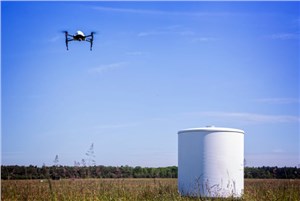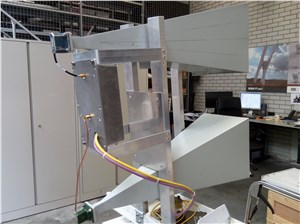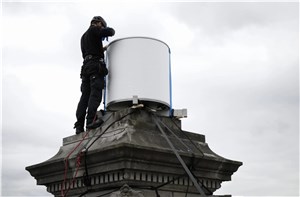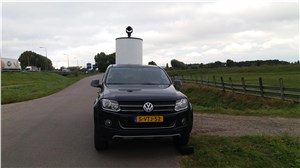



After a decade of groundbreaking service, it’s time to officially say goodbye to ELVIRA, the very first purpose-built drone detection radar in the market.
Our first drone radar may have been discontinued, but it’s still driving everything that comes next. ELVIRA sent us soaring, in 2D, into the defence and security market all the way back in 2014.
It laid the groundwork for some of our core technologies and achievements: from micro-Doppler classification and rapid prototyping to real-world deployment under pressure.

Market forecast by Region, End-User, and Mitigation Type. Country Analysis, Market and Technology Overview including Critical Raw Materials, Opportunity Analysis, and Leading Company Profiles
Download free sample pages More informationELVIRA taught us how to move fast without compromising, to innovate boldly, and think with those on the front lines of airspace defence and security.
Now, as we commit full focus to the unique combination of 360° coverage and 3D insights, we celebrate the undeniable legacy ELVIRA leaves.
An emerging and elusive threat
In 2014, drone use was advancing fast. Their availability and commercialisation were surging, with elusive builds and increasingly capable flight powers. They were fast becoming a formidable threat to airspace safety and security everywhere.
Back then, we used drones in testing cycles (and still do). We knew our radars could detect them, and that we had the potential to help. But, could we build a radar that distinguishes drones from birds, classifies them accurately and tracks their erratic flight?
The challenge was steep, but the answer became ELVIRA.
Although ELVIRA was carefully considered, it was born from a burning need and innovated at lightning speed. Amazingly, within a year of beginning the project, our specialised 2D radar had landed in the defence and security market.
Robin Radar System Specialist, Wouter Keijer, was one of the engineers leading ELVIRA’s rapid launch. He said, “We wanted to get a robust and capable CUAS radar to market as soon as possible. That meant reusing a lot of components from our avian radar and relying on COTS (commercial off-the-shelf) parts for the rest.
“The real innovation was in its micro-Doppler technology, which allowed ELVIRA to classify drones by their propeller signatures. That was a wholly new concept for us at the time.
“We aimed to keep things simple: a 2D rotating radar using FMCW (Frequency Modulated Continuous Wave) technology, low power, and micro-Doppler capability. We made it affordable, capable, and reliable. In that sense, ELVIRA did what few radar systems could do at the time.”
Deployments that put ELVIRA on the map
Once launched, ELVIRA quickly proved its worth in mission-critical environments. The system gave us a solid foothold in the defence and security sector, going on to establish our name as a trusted provider worldwide.
Plenty of high-profile deployments presented unique logistical challenges. Every one of them demanded an advanced detection system that could be trusted under pressure, and ELVIRA delivered every time.
Some favourites in ELVIRA’s montage of real-world missions:
2016 – Hanover Fair, Germany
ELVIRA played a central role in securing the world’s largest industrial technology trade fair during a state visit by U.S. President Barack Obama and German Chancellor Angela Merkel. With thousands of attendees and global media coverage, it presented a complex security landscape in a densely populated urban setting.
2017 – G20 Summit, Hamburg
Amid widespread demonstrations and elevated geopolitical tensions, ELVIRA formed part of the multi-layered surveillance protecting heads of state and government at this important summit.
2018 – NATO Summit, Brussels
This important NATO Summit required coordinated international security efforts across multiple jurisdictions. ELVIRA’s detection capabilities reinforced the integrity of highly protected airspace during the summit’s critical decision-making sessions. How it reached its deployment position was just as impressive as the radar’s performance itself (involving a helicopter and a very brave engineer)!
Engineering breakthroughs
Let’s rewind to the gruelling engineering that made every deployment a success. Though ELVIRA was created at pace, that certainly didn’t detract from any of the glaring innovations of its time.
Over the years, ELVIRA continued to undergo pivotal advancements that enhanced capabilities, durability, and integration potential.
Here are just a few:
Triumphs in testing
Every engineering milestone ELVIRA made was sealed in hundreds of testing cycles. Some sent us back to the drawing board, others made leaps and bounds in formidable detection, classification and tracking powers.
From rapid prototyping under time constraints to performance trials in extreme environments, here are a few stand-out moments:
The radar that brought Robin into three dimensions
Our decision to discontinue the 2D ELVIRA underscores a laser focus on full, 360 awareness in 3D going forward. But we didn't take it lightly.
ELVIRA was our first jump into a challenging market, a proving ground for radar innovation, and a launchpad that propelled us into the defence and security space.
But as the threat landscape continues to evolve, so do we. We firmly believe that the future of drone detection is three-dimensional, where azimuth, elevation and range intersect in complex airspace with no room for doubt and no time to second-guess.
That’s why we’re pivoting innovation efforts fully to radars like IRIS, designed from the ground up to deploy faster than ever, offering 360° coverage with precise 3D insights. Importantly, IRIS inherits and amplifies every lightbulb moment that made ELVIRA a true trailblazer in the C-UAS radar space.
In that way, ELVIRA will echo on in every scan, detection, and breakthrough the next generation of Robin Radar systems make.
Our first drone radar has served its purpose brilliantly. Farewell ELVIRA — thank you for a legacy of innovation that will carry us for years to come.